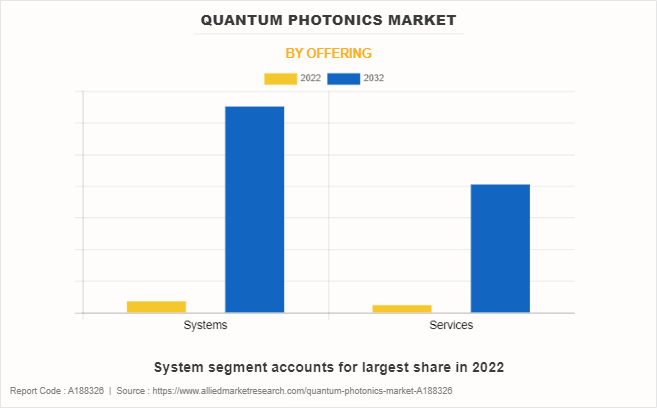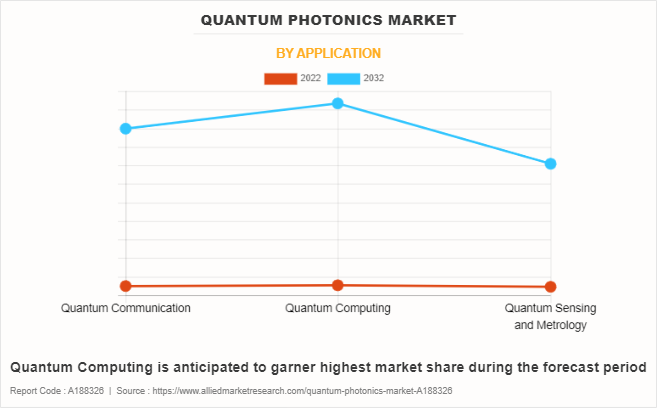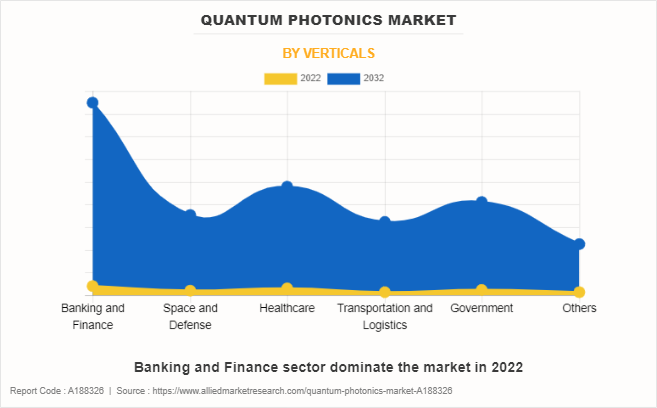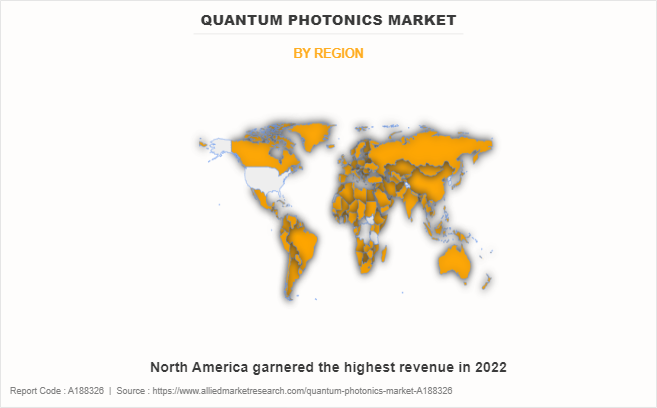Quantum Photonics Market Research, 2032
The Global Quantum Photonics Market was valued at $0.3 billion in 2022, and is projected to reach $5.3 billion by 2032, growing at a CAGR of 33.2% from 2023 to 2032.
Quantum photonics is the scientific exploration and control of light particles, known as photons, at the quantum level, where the laws of quantum mechanics govern their behavior. This field focuses on understanding and utilizing the distinct quantum properties of photons to achieve a wide range of applications.

These applications encompass quantum communication, cryptography, computation, and sensing. The main objective of quantum photonics is to harness the unique quantum characteristics of photons and manipulate them at the atomic and subatomic scales, leading to cutting-edge technologies and business applications. These advancements include developing secure quantum communication systems to safeguard data, revolutionizing computational capabilities with quantum computing, and improving precision measurements and sensors across various industries.
Segment Overview
The quantum photonics market is segmented into Offering, Application and Verticals.

On the basis of offering, the market is divided into systems and services. In 2022, system segment acquired the largest share in 2022 and is expected to grow at a significant CAGR from 2023 to 2032.

On the basis of application, the market is classified into quantum communication, quantum computing, quantum sensing, and metrology. In 2022, quantum computing segment dominate the market in terms of revenue.

On the basis of vertical, the market is segmented into banking and finance, space and defense, healthcare, transportation and logistics, government, and others. In 2022, the Banking and finance sector dominate the market.

By region, it is analyzed across North America (the U.S., Canada, and Mexico), Europe (UK, Germany, France, and rest of Europe), Asia-Pacific (China, Japan, India, South Korea, and rest of Asia-Pacific), and LAMEA (Latin America, the Middle East, and Africa). The Asia-Pacific quantum photonics market industry is expected to grow at the highest CAGR during the forecast period.
The growth of the quantum photonics industry is fueled by the progress in quantum technologies such as computing, communication, and sensing. These advancements drive the need for photonics-based components and systems capable of manipulating individual photons. As quantum technologies continue to advance, the demand for photon-based quantum systems and applications is expected to rise significantly in various industries and research fields. This mutual advancement between quantum technologies and quantum photonics forms a virtuous cycle, accelerating the development and adoption of quantum-based solutions in the quantum photonics industry.
Furthermore, the increase in demand for secure communication is an important driver for the growth of the quantum photonics market. With increase in demand for secure communication across various industries such as governments, banks, and various business industries to protect their sensitive data from sophisticated cyber threats, the demand for quantum communication systems based on quantum photonics continues to rise. For instance, the European Space Agency (ESA) launched the "Quantum Experiments at Space Scale" (QUESS) satellite, also known as "Micius' sister," to conduct experiments in quantum communication. This satellite aimed to explore quantum communication capabilities across continental distances.
However, high cost hinders the growth of the market as quantum photonics generally require sophisticated and precise equipment, advanced materials, and specialized expertise, all of which contribute to elevated production and implementation costs. Quantum photonics systems, such as those used in quantum computing or quantum communication, demand expensive components like superconducting materials, cryogenic cooling, and high-end laser sources. Therefore, the initial investment and maintenance costs for quantum photonics solutions can be prohibitively high, deterring some businesses and industries from fully embracing the technology.
The surge in demand for secure and high-performance solutions presents a significant opportunity for the quantum photonics market in the coming years. This demand for ultra-secure communication presents a significant growth opportunity for quantum photonics companies to develop and deploy quantum communication networks and quantum key distribution (QKD) systems. The need for robust encryption and secure communication solutions has become critical as industries and governments grapple with escalating cybersecurity threats and data privacy concerns. Quantum photonics offers a game-changing approach with quantum key distribution (QKD), providing unbreakable encryption using entangled photons. For instance, governments and organizations globally invest in the development of quantum communication networks to establish secure communication channels between critical infrastructure and government agencies. Thereby creating an opportunity for market growth.
Top Impacting Factors
The market for quantum photonics market is anticipated to expand significantly during the forecast period, owing to an increase in demand for secure communication. In addition, advancements in quantum technologies fuel market growth. Moreover, quantum electrodynamics is anticipated to benefit, owing to the surge in demand for secure and high-performance solutions, and is expected to present enormous opportunities for the market during the forecast period. However, the high costs of making quantum photonics and the need for professional technicians are anticipated to restrain market growth during the forecast period.
Competitive Analysis
The key players profiled in the report include Toshiba, Xanadu, Quandela, ID Quantique, ORCA Computing Limited, PsiQuantum, Tundra Systems Global LTD., Quix Quantum BV, IBM, and MagiQ Technologies. These key players have adopted strategies, such as product portfolio investments, expansion, and product launch to enhance their position in the quantum photonics market outlook.
Historical Data & Information
The quantum photonics market size is highly competitive, owing to the strong presence of existing vendors. Vendors in the quantum photonics market with extensive technical and financial resources are expected to gain a competitive advantage over their competitors as they can cater to market demands. The competitive environment in this market is expected to increase owing to technological innovations, product extensions, and different strategies adopted by key vendors increase.
Key Developments/ Strategies
Toshiba, Xanadu, Quandela, ID Quantique, ORCA Computing Limited, PsiQuantum, Tundra Systems Global LTD., Quix Quantum BV, IBM, and MagiQ Technologies are the top companies holding a prime share in the global quantum photonics market. Top market players have adopted various strategies, such as expansion and investment to expand their foothold in the global quantum photonics market.
- In March 2023, Cryptonext Security and Quandela announced a business partnership to provide an integrated security solution. The collaboration aims to leverage Quandela's expertise in photonic technologies for enhanced encryption and security measures in Cryptonext's products. The integrated solution is expected to offer advanced data protection and address security challenges in various industries.
- In October 2022, Quandela signed a partnership with the Electronics and Information Technology Laboratory of the French Atomic Energy Commission (CEA-Leti) to produce a 100% French high-performance photonic chip. This partnership is expected to allow Quandela to fully control the process of creating these photonic chips.
- In June 2022, Xanadu launched Borealis, a quantum photonics-based computer with 216 squeezed- state qubits, which is almost twenty times more than X12.
Key Benefits For Stakeholders
- This report provides a quantitative analysis of the market segments, current trends, estimations, and dynamics of the quantum photonics market analysis from 2022 to 2032 to identify the prevailing quantum photonics market opportunity.
- The market research is offered along with information related to key drivers, restraints, and opportunities.
- Porter's five forces analysis highlights the potency of buyers and suppliers to enable stakeholders make profit-oriented business decisions and strengthen their supplier-buyer network.
- In-depth analysis of the quantum photonics market share segmentation assists to determine the prevailing market opportunities.
- Major countries in each region are mapped according to their revenue contribution to the global quantum photonics market forecast.
- Market player positioning facilitates benchmarking and provides a clear understanding of the present position of the market players.
- The report includes the analysis of the regional as well as global quantum photonics market trends, key players, market segments, application areas, and quantum photonics market growth strategies.
Quantum Photonics Market Report Highlights
| Aspects | Details |
| Market Size By 2032 | USD 5.3 billion |
| Growth Rate | CAGR of 33.2% |
| Forecast period | 2022 - 2032 |
| Report Pages | 250 |
| By Offering |
|
| By Application |
|
| By Verticals |
|
| By Region |
|
| Key Market Players | Xanadu, IBM Corporation, Quandela, MagiQ Technologies, Inc., PsiQuantum, ORCA Computing Limited, Quix Quantum BV, ID Quantique, TundraSystems Global LTD., Toshiba Corporation |
Analyst Review
The global quantum photonics market holds high potential for the semiconductor industry. The business scenario witnesses increase in demand for quantum photonics devices, particularly in developing regions, such as China, Japan, U.S., UK, and others. Companies in this industry are adopting various innovative techniques to provide customers with advanced and innovative product offerings.?
Rise in demand for secure communication and advancement in quantum technologies drive the growth of the market. However, cost impedes this growth. Furthermore, an increase in demand for secure and high-performance solutions is expected to create lucrative opportunities for the key players operating in the market.?
The market participants are expected to introduce technologically advanced products to remain competitive in the market. Product launch and collaboration are the prominent strategies adopted by market players. For instance, Xanadu launched Borealis, a photonic-based quantum computer. According to Xanadu, Borealis is the world's largest photonic quantum computer with 216 squeezed-state qubits. Xanadu claims to achieve the quantum advantage due to Borealis’ capability of performing a task in 36 microseconds, which would take more than 9,000 years for a supercomputer
Quantum computing is the upcoming trends of quantum photonics market in the world.
Quantum computing is the leading application of quantum photonics market.
North America is the largest regional market for quantum photonics.
$0.3 billion is the estimated industry size of quantum photonics market.
Toshiba, Xanadu, Quandela, ID Quantique, ORCA Computing Limited, PsiQuantum, Tundra Systems Global LTD., Quix Quantum BV, IBM, and MagiQ Technologies are the top companies to hold the market share in quantum photonics market.
Loading Table Of Content...
Loading Research Methodology...



